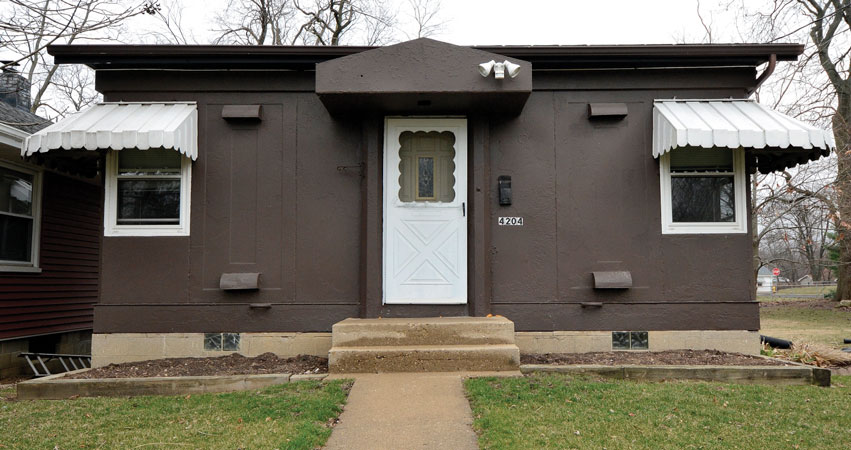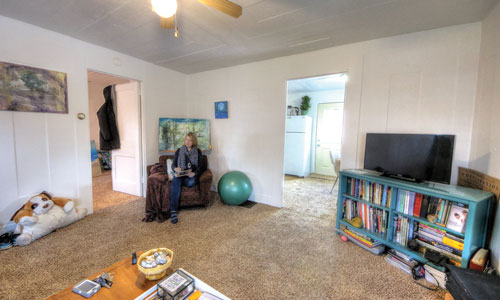
Form follows function—that has been misunderstood. Form and function should be one, joined in a spiritual union.”
—Frank Lloyd Wright
Considering the 80-year gap, it’s surprisingly easy to trace the spiritual connection between the industrialist and the artist.
In 1937, Robert “R.G.” LeTourneau was an ironworker, carpenter, inventor, contractor and businessman whose earthmoving company had recently relocated in central Illinois to be close to Caterpillar Tractor Co. In 2017, Sarah Nesbit lives, works, paints, plays and teaches in one of the tiny steel homes he masterminded as affordable housing for a Peoria workforce battered by the Great Depression.
He might call it practical art. She might call it artistically practical. From the Wright perspective, they’re both correct, in a “Carefree Home” where form melds with function.
 LeTourneau’s Innovative Eye
LeTourneau’s Innovative Eye
Although he is not particularly well-known in Peoria today, LeTourneau’s impact was felt far beyond central Illinois. Born in Virginia and mostly self-educated in Oregon and California, LeTourneau held more than 300 patents. His earth-moving company worked on the Hoover Dam in the 1930s, before he moved near the company which made engines for his machines.
The phrase “walk the talk” may or may not have been popular at that time, but the fellow known as “God’s businessman” was a believer that his workers should be well-treated. He offered a non-mandatory chapel hour at his factory where the boss was seen regularly, and later founded LeTourneau Technical Institute in Longview, Texas as a means to re-educate GIs returning from World War II. Then, and now, as LeTourneau University, it has been a nondenominational Christian school.
When LeTourneau realized how difficult it was for his Peoria workforce to find a place to live, he focused his innovative eye on the problem. The result was the Carefree Home. Entirely made of steel and sealed, these small houses were not only designed by LeTourneau, they were manufactured by his company. Most often a 24-foot flat-roofed square, the houses were made of steel panels welded to form inner and outer walls, with room left in-between for insulation.
Supposedly, the houses were safe from everything from termites to fire to floods—hence, carefree. (LeTourneau did recognize a metal building might not be weather-proof. He wanted his little steel houses to be air-conditioned.) Among their other virtues, Carefree houses could float. Some were shipped along the Illinois River. Others, with brackets already installed on their sides for portability, were moved via a specially-built truck.
 Plans for an entire Carefree community were thwarted by the steel shortages of World War II. But to this day, many Carefree houses are occupied. Even when they have been refashioned with everything from awnings to a whole-house addition, these houses can be recognized by their distinctive corner windows. There are several in Peoria Heights near the village tower, including one on the 1100 block of Glen Avenue.
Plans for an entire Carefree community were thwarted by the steel shortages of World War II. But to this day, many Carefree houses are occupied. Even when they have been refashioned with everything from awnings to a whole-house addition, these houses can be recognized by their distinctive corner windows. There are several in Peoria Heights near the village tower, including one on the 1100 block of Glen Avenue.
True to its Origins
The Carefree Home where Nesbit lives has been in Penny Post-Freeman’s family for more than 50 years. Her father, Victor Post, was a mail carrier who was handy enough to rent houses as a sideline. He bought a Carefree Home next door to what is now Prospect Florist and moved it himself to 4204 N. Columbus in 1964. The rent was $65. “We just cursed this house—my mom did,” Post-Freeman laughs.
As she recalls, her mother, Jewell Post, was not unhappy with the house so much as some tenants. Jewell Post was the one who had to clean up when less-than-tidy occupants moved out. But the Carefree Home proved pretty much just that. Other than new carpeting, a slightly-sloped roof and new windows, the house remains true to its origins. Somebody even heeded the “Please do not remove!” sticker on the kitchen cabinets. It’s still in place on storage units which have indeed been “Step saving! Time saving! Money saving!”
In fact, the rental arrangements worked well enough that Post-Freeman bought the house when her father died in 1997. She lives next door and owns many of the homes on the block with her husband, Peter Freeman. “Peter and I say we wish we had about 20 of these over by Bradley,” she adds.
Post-Freeman says tenants are like family, and hugs Nesbit to prove her point. That has been tested, too, since their houses are only about 10 feet apart. Post-Freeman sometimes hears Nesbit teaching English as a second language to Chinese children over the Internet at 2am.
 Not only is Nesbit’s kitchen a classroom, her living room is her yoga/art studio. Those Carefree corner windows offer yogi-friendly light, which makes a little house look larger—and inspires painting as well. It may be small, but the place is multi-purpose. “I really use it,” Nesbit notes.
Not only is Nesbit’s kitchen a classroom, her living room is her yoga/art studio. Those Carefree corner windows offer yogi-friendly light, which makes a little house look larger—and inspires painting as well. It may be small, but the place is multi-purpose. “I really use it,” Nesbit notes.
Just turning 41, Nesbit is a Richwoods High School graduate who returned to this area in 2012. She had earned a graduate degree from the Art Institute of Chicago, where she lived for 15 years, and has explored work as an artist ever since. She knows it helps to be practical when you live for art. So an efficient, economical dwelling “almost like a shipping container” was more appealing than daunting. If anything, travels abroad attuned her to the architectural possibilities.
“I lived in Germany for a couple years,” Nesbit says. “In Berlin, I lived in a Bauhaus apartment. This house has that kind of feel to it.”
A cold-in-the-winter, hot-in-the-summer steel house isn’t for everyone. Storing personal items requires thought in a tiny space, even if you can attach stuff to the walls with magnets. But it works for Nesbit (and her two cats). “It’s perfect to have your own little house,” she says. “It feels like a cabin—a retreat.”
No doubt LeTourneau would be pleased.
A Unique Collaboration
About 20 Carefree houses, including Nesbit’s, remain in the Peoria area. One of them was used as office space until the 1980s by the various companies that evolved from LeTourneau’s original factory alongside the Illinois River. Recently, the final owner, Komatsu America Corp., agreed to donate it for a museum exhibit so visitors could see for themselves what LeTourneau envisioned so many decades ago.
Sandblasted, patched and renovated, the house is slated to move to Wheels O’ Time Museum in Dunlap later this year. The $180,000 restoration is a unique collaboration between the Peoria Historical Society, Central Illinois Landmarks Foundation and the museum. With dozens of contributors and support from the Caterpillar Foundation, the project already has raised more than half of the needed funds. To donate or learn more, visit steelhouserevival.com. iBi
Terry Bibo is a freelance journalist who keeps a likeness of R.G. LeTourneau in her top desk drawer. Greg Neaveill is a freelance photographer who flies planes and crafts his own telescopes.

